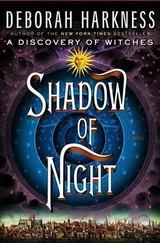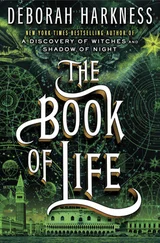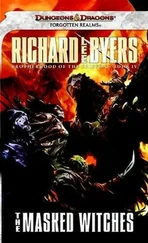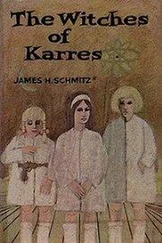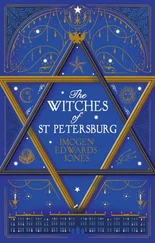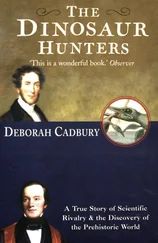The wooden toy at the far right of the top shelf was at eye level now. I sucked in a deep breath and pulled out the first item from the opposite end. It was ancient—the oldest manuscript I’d ever handled. The leather cover complained when it opened, and the smell of old sheepskin rose from the pages.
“Carmina qui quondam studio florente peregi, / Flebilis heu maestos cogor inire modos,” read the first lines. My eyes pricked with tears. It was Boethius’s sixth-century work, The Consolation of Philosophy, written in prison while he was awaiting death. “To pleasant songs my work was once given, and bright were all my labors then; / But now in tears to sad refrains I must return.” I imagined Matthew, bereft of Blanca and Lucas and bewildered by his new identity as a vampire, reading words written by a condemned man. Giving silent thanks to whoever had offered him this in hope of lessening his grief, I slid the book back into place.
The next volume was a beautifully illustrated manuscript of Genesis, the biblical story of creation. Its strong blues and reds looked as fresh as the day they had been painted. Another illustrated manuscript, this one a copy of Dioscorides’ book of plants, was also on the top shelf, along with more than a dozen other biblical books, several law books, and a book in Greek.
The shelf below held more of the same—books of the Bible mostly, along with a medical book and a very early copy of a seventh-century encyclopedia. It represented Isidore of Seville’s attempt to capture all of human knowledge, and it would have appealed to Matthew’s endless curiosity. At the bottom of the first folio was the name “MATHIEU,” along with the phrase “meus liber”—“my book.”
Feeling the same urge to trace the letters as when I faced Ashmole 782 in the Bodleian, my fingers faltered on their way to the surface of the vellum. Then I’d been too afraid of the reading-room supervisors and my own magic to risk it. Now it was fear of learning something unexpected about Matthew that held me back. But there was no supervisor here, and my fears became insignificant when weighed against my desire to understand the vampire’s past. I traced Matthew’s name. An image of him, sharp and clear, came to me without the use of stern commands or shining surfaces.
He was seated at a plain table by a window, looking just as he did now, biting his lip with concentration as he practiced his writing. Matthew’s long fingers gripped a reed pen, and he was surrounded by sheets of vellum, all of which bore repeated blotchy attempts to write his own name and copy out biblical passages. Following Marthe’s advice, I didn’t fight the vision’s arrival or departure, and the experience was not as disorienting as it had been last night.
Once my fingers had revealed all they could, I replaced the encyclopedia and continued working my way through the remaining volumes in the case. There were history books, more law books, books on medicine and optics, Greek philosophy, books of accounts, the collected works of early church notables like Bernard of Clairvaux, and chivalric romances—one involving a knight who changed into a wolf once a week. But none revealed fresh information about the Knights of Lazarus. I bit back a sound of frustration and climbed down from the table.
My knowledge of Crusader orders was sketchy. Most of them started out as military units that were renowned for bravery and discipline. The Templars were famous for being the first to enter the field of battle and the last to leave. But the orders’ military efforts were not limited to the area around Jerusalem. The knights fought in Europe, too, and many answered only to the pope rather than to kings or other secular authorities.
Nor was the power of the chivalric orders solely military. They’d built churches, schools, and leper hospitals. The military orders safeguarded Crusader interests, whether spiritual, financial, or physical. Vampires like Matthew were territorial and possessive to the last, and therefore ideally suited to the role of guardians.
But the power of the military orders led ultimately to their downfall. Monarchs and popes were jealous of their wealth and influence. In 1312 the pope and the French king saw to it that the Templars were disbanded, ridding themselves of the threat posed by the largest, most prestigious brotherhood. Most of the other orders gradually petered out due to lack of support and interest.
There were all those conspiracy theories, of course. A vast, complex international institution is hard to dismantle overnight, and the sudden dissolution of the Knights Templar had led to all sorts of fantastic tales about rogue Crusaders and underground operations. People still searched for traces of the Templars’ fabulous wealth. The fact that no one had ever found evidence of how it was disbursed only added to the intrigue.
The money. It was one of the first lessons historians learned: follow the money. I refocused my search.
The sturdy outlines of the first ledger were visible on the third shelf, tucked between Al-Hazen’s Optics and a romantic French chanson de geste. A small Greek letter was inked on the manuscript’s fore edge: α. Figuring it must be an indexing mark of some sort, I scanned the shelves and located the second account book. It, too, had a small Greek letter, β. My eyes lit on γ, δ, and ε, scattered among the shelves, too. A more careful search would locate the rest, I was sure.
Feeling like Eliot Ness waving a fistful of tax receipts in pursuit of Al Capone, I held up my hand. There was no time to waste on climbing to retrieve it. The first account book slid from its resting place and fell into my waiting palm.
Its entries were dated 1117 and were made by a number of different hands. Names and numbers danced across the pages. My fingers were busy, taking in all the information they could from the writing. A few faces bloomed out of the vellum repeatedly—Matthew, the dark man with the hawkish nose, a man with bright hair the color of burnished copper, another with warm brown eyes and a serious face.
My hands stilled over an entry for money received in 1149. “Eleanor Regina, 40,000 marks.” It was a staggering sum—more than half the yearly income of the kingdom of England. Why was the queen of England giving so much to a military order led by vampires? But the Middle Ages were too far outside my expertise for me to be able to answer that question or to know much about the people engaging in the transfers. I shut the book with a snap and went to the sixteenth- and seventeenth-century bookcases.
Nestled among the other books was a volume bearing the identifying mark of a Greek lambda. My eyes widened once it was open.
Based on this ledger, the Knights of Lazarus had paid—somewhat unbelievably—for a wide range of wars, goods, services, and diplomatic feats, including providing Mary Tudor’s dowry when she married Philip of Spain, buying the cannon for the Battle of Lepanto, bribing the French so they’d attend the Council of Trent, and financing most of the military actions of the Lutheran Schmalkaldic League. Apparently the brotherhood didn’t allow politics or religion to get in the way of their investment decisions. In a single year, they’d bankrolled Mary Stuart’s return to the Scottish throne and paid off Elizabeth I’s sizable debts to the Antwerp Bourse.
I walked along the shelves looking for more books marked with Greek letters. On the nineteenth-century shelves, there was one with the forked letter psi on its faded blue buckram spine. Inside, vast sums of money were meticulously accounted for, along with property sales that made my head spin—how did one secretly purchase most of the factories in Manchester?—and familiar names belonging to royalty, aristocrats, presidents, and Civil War generals. There were also smaller payouts for school fees, clothing allowances, and books, along with entries concerning dowries paid, hospital bills settled, and past-due rents brought up to date. Next to all the unfamiliar names was the abbreviation “MLB” or “FMLB.”
Читать дальше

